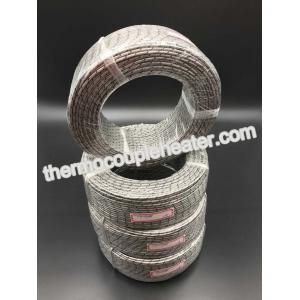
Add to Cart
3 x 19 x 0.18 PT 100 Sheath Nickel Plated Copper Braided Wire Inner Fiberglass Insulation Outer
1. Introduction
Resistance thermometers, also called resistance temperature detectors (RTDs), are sensors used to measure temperature. Many RTD elements consist of a length of fine wire wrapped around a ceramic or glass core but other constructions are also used. The RTD wire is a pure material, typically platinum, nickel, or copper. The material has an accurate resistance/temperature relationship which is used to provide an indication of temperature. As RTD elements are fragile, they are often housed in protective probes.
Common RTD sensing elements constructed of platinum, copper or nickel have a repeatable resistance versus temperature relationship (R vs T) and operating temperature range. The R vs T relationship is defined as the amount of resistance change of the sensor per degree of temperature change.The relative change in resistance (temperature coefficient of resistance) varies only slightly over the useful range of the sensor.
Platinum is the best metal for RTDs due to its very linear resistance–temperature relationship, highly repeatable over a wide temperature range. The unique properties of platinum make it the material of choice for temperature standards over the range of −272.5 °C to 961.78 °C. It is used in the sensors that define the International Temperature Standard, ITS-90. Platinum is chosen also because of its chemical inertness.
The significant characteristic of metals used as resistive elements is the linear approximation of the resistance versus temperature relationship between 0 and 100 °C. This temperature coefficient of resistance is denoted by α and is usually given in units of /(Ω·°C):
sed toThe current international standard that specifies tolerance and the temperature-to-electrical resistance relationship for platinum resistance thermometers (PRTs) is IEC 60751:2008; ASTM E1137 is also used in the United States. By far the most common devices used in industry have a nominal resistance of 100 ohms at 0 °C and are called Pt100 sensors ("Pt" is the symbol for platinum, "100" for the resistance in ohms at 0 °C). measure temperature. Many RTD elements consist of a length of fine wire w
Fixed point calibration
is used for the highest-accuracy calibrations by national metrology laboratories.[4] It uses the triple point, freezing point or melting point of pure substances such as water, zinc, tin, and argon to generate a known and repeatable temperature. These cells allow the user to reproduce actual conditions of the ITS-90 temperature scale. Fixed-point calibrations provide extremely accurate calibrations (within ±0.001 °C). A common fixed-point calibration method for industrial-grade probes is the ice bath. The equipment is inexpensive, easy to use, and can accommodate several sensors at once. The ice point is designated as a secondary standard because its accuracy is ±0.005 °C (±0.009 °F), compared to ±0.001 °C (±0.0018 °F) for primary fixed points.
Comparison calibrations
is commonly used with secondary SPRTs and industrial RTDs. The thermometers being calibrated are compared to calibrated thermometers by means of a bath whose temperature is uniformly stable. Unlike fixed-point calibrations, comparisons can be made at any temperature between −100 °C and 500 °C (−148 °F to 932 °F). This method might be more cost-effective, since several sensors can be calibrated simultaneously with automated equipment. These electrically heated and well-stirred baths use silicone oils and molten salts as the medium for the various calibration temperatures.
rapped around a ceramic or glass core but other constructions are also used. The RTD wire is a pure m2. Competitive Advantage



3. Application